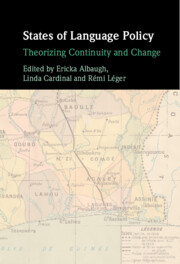Book contents
- States of Language Policy
- States of Language Policy
- Copyright page
- Contents
- Figures
- Tables
- Contributors
- Acknowledgments
- Introduction
- Part I Routes of Change
- Part II Dependent Relationships
- Part III Levels of Governance
- 11 Indigenous Reconciliation and the Limits of Canada’s Language Regime
- 12 State Tradition and Language Revitalization in Wales
- 13 Language Regime Change and Europeanization
- 14 Language Regimes, Global English, and National Public Education
- Conclusion
- Index
- References
13 - Language Regime Change and Europeanization
The Council of Europe, Slovakia, and the Treatment of Romani
from Part III - Levels of Governance
Published online by Cambridge University Press: 14 November 2024
- States of Language Policy
- States of Language Policy
- Copyright page
- Contents
- Figures
- Tables
- Contributors
- Acknowledgments
- Introduction
- Part I Routes of Change
- Part II Dependent Relationships
- Part III Levels of Governance
- 11 Indigenous Reconciliation and the Limits of Canada’s Language Regime
- 12 State Tradition and Language Revitalization in Wales
- 13 Language Regime Change and Europeanization
- 14 Language Regimes, Global English, and National Public Education
- Conclusion
- Index
- References
Summary
In an increasingly integrated Europe, state language regimes are not the only ones that matter. It is also essential to understand how they interact with supranational language regimes. As Central and Eastern European (CEE) countries worked towards and then gained European Union membership after 2000, to what extent did their state language regimes become “Europeanized”? This question is examined through the case of Romani in Slovakia. The chapter has two aims: first, to demonstrate that the concept of a language regime can be fruitfully applied to supranational entities, and second, to examine the impact of such regimes at the state level. The Council of Europe’s language regime led it to advocate for increased support of Romani, as well as increased minority language rights in member states more generally. This work became bound up in the wider dynamics of Europeanization and European pressure on CEE states. At the level of the Slovak state, official policies towards Romani were changed in response to such pressure. Implementation of such commitments was limited, however. An analysis of state treatment of Romani language in Slovakia from approximately 1998 to 2018 thus illustrates a process through which a state language regime was altered but not transformed.
- Type
- Chapter
- Information
- States of Language PolicyTheorizing Continuity and Change, pp. 246 - 266Publisher: Cambridge University PressPrint publication year: 2024

